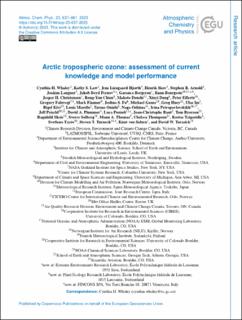| dc.contributor.author | Whaley, Cynthia | |
| dc.contributor.author | Law, Kathy S. | |
| dc.contributor.author | Hjorth, Jens Liengaard | |
| dc.contributor.author | Skov, Henrik | |
| dc.contributor.author | Arnold, Stephen R. | |
| dc.contributor.author | Langner, Joakim | |
| dc.contributor.author | Pernov, Jakob Boyd | |
| dc.contributor.author | Bergeron, Garance | |
| dc.contributor.author | Bourgeois, Ilann | |
| dc.contributor.author | Christensen, Jesper H. | |
| dc.contributor.author | Chien, Rong-You | |
| dc.contributor.author | Deushi, Makoto | |
| dc.contributor.author | Dong, Xinyi | |
| dc.contributor.author | Effertz, Peter | |
| dc.contributor.author | Faluvegi, Gregory | |
| dc.contributor.author | Flanner, Mark G. | |
| dc.contributor.author | Fu, Joshua S. | |
| dc.contributor.author | Gauss, Michael | |
| dc.contributor.author | Huey, Greg L. | |
| dc.contributor.author | Im, Ulas | |
| dc.contributor.author | Kivi, Rigel | |
| dc.contributor.author | Marelle, Louis | |
| dc.contributor.author | Onishi, Tatsuo | |
| dc.contributor.author | Oshima, Naga | |
| dc.contributor.author | Petropavlovskikh, Irina | |
| dc.contributor.author | Peischl, Jeff | |
| dc.contributor.author | Plummer, David A. | |
| dc.contributor.author | Pozzoli, Luca | |
| dc.contributor.author | Raut, Jean-Christophe | |
| dc.contributor.author | Ryerson, Tom | |
| dc.contributor.author | Skeie, Ragnhild Bieltvedt | |
| dc.contributor.author | Solberg, Sverre | |
| dc.contributor.author | Thomas, Manu Anna | |
| dc.contributor.author | Thompson, Chelsea R. | |
| dc.contributor.author | Tsigaridis, Kostas | |
| dc.contributor.author | Tsyro, Svetlana | |
| dc.contributor.author | Turnock, Steven T. | |
| dc.contributor.author | von Salzen, Knut | |
| dc.contributor.author | Tarasick, David | |
| dc.date.accessioned | 2024-02-14T14:05:02Z | |
| dc.date.available | 2024-02-14T14:05:02Z | |
| dc.date.created | 2023-01-18T10:59:28Z | |
| dc.date.issued | 2023 | |
| dc.identifier.citation | Atmospheric Chemistry and Physics (ACP). 2023, 23 637-661. | en_US |
| dc.identifier.issn | 1680-7316 | |
| dc.identifier.uri | https://hdl.handle.net/11250/3117614 | |
| dc.description.abstract | As the third most important greenhouse gas (GHG) after carbon dioxide (CO2) and methane (CH4), tropospheric ozone (O3) is also an air pollutant causing damage to human health and ecosystems. This study brings together recent research on observations and modeling of tropospheric O3 in the Arctic, a rapidly warming and sensitive environment. At different locations in the Arctic, the observed surface O3 seasonal cycles are quite different. Coastal Arctic locations, for example, have a minimum in the springtime due to O3 depletion events resulting from surface bromine chemistry. In contrast, other Arctic locations have a maximum in the spring. The 12 state-of-the-art models used in this study lack the surface halogen chemistry needed to simulate coastal Arctic surface O3 depletion in the springtime; however, the multi-model median (MMM) has accurate seasonal cycles at non-coastal Arctic locations. There is a large amount of variability among models, which has been previously reported, and we show that there continues to be no convergence among models or improved accuracy in simulating tropospheric O3 and its precursor species. The MMM underestimates Arctic surface O3 by 5 % to 15 % depending on the location. The vertical distribution of tropospheric O3 is studied from recent ozonesonde measurements and the models. The models are highly variable, simulating free-tropospheric O3 within a range of ±50 % depending on the model and the altitude. The MMM performs best, within ±8 % for most locations and seasons. However, nearly all models overestimate O3 near the tropopause (∼300 hPa or ∼8 km), likely due to ongoing issues with underestimating the altitude of the tropopause and excessive downward transport of stratospheric O3 at high latitudes. For example, the MMM is biased high by about 20 % at Eureka. Observed and simulated O3 precursors (CO, NOx, and reservoir PAN) are evaluated throughout the troposphere. Models underestimate wintertime CO everywhere, likely due to a combination of underestimating CO emissions and possibly overestimating OH. Throughout the vertical profile (compared to aircraft measurements), the MMM underestimates both CO and NOx but overestimates PAN. Perhaps as a result of competing deficiencies, the MMM O3 matches the observed O3 reasonably well. Our findings suggest that despite model updates over the last decade, model results are as highly variable as ever and have not increased in accuracy for representing Arctic tropospheric O3. | en_US |
| dc.description.abstract | Arctic tropospheric ozone: assessment of current knowledge and model performance | en_US |
| dc.language.iso | eng | en_US |
| dc.publisher | EGU | en_US |
| dc.rights | Navngivelse 4.0 Internasjonal | * |
| dc.rights.uri | http://creativecommons.org/licenses/by/4.0/deed.no | * |
| dc.title | Arctic tropospheric ozone: assessment of current knowledge and model performance | en_US |
| dc.title.alternative | Arctic tropospheric ozone: assessment of current knowledge and model performance | en_US |
| dc.type | Peer reviewed | en_US |
| dc.type | Journal article | en_US |
| dc.description.version | publishedVersion | en_US |
| dc.subject.nsi | VDP::Matematikk og Naturvitenskap: 400 | en_US |
| dc.source.pagenumber | 637-661 | en_US |
| dc.source.volume | 23 | en_US |
| dc.source.journal | Atmospheric Chemistry and Physics (ACP) | en_US |
| dc.identifier.doi | 10.5194/acp-23-637-2023 | |
| dc.identifier.cristin | 2109199 | |
| cristin.ispublished | true | |
| cristin.fulltext | original | |
| cristin.qualitycode | 2 | |

